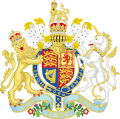Emblem of Djibouti
| National Emblem of Djibouti | |
|---|---|
 | |
| Armiger | Republic of Djibouti |
| Adopted | 1977 |
The national emblem of Djibouti was introduced after attaining independence from France on 27 June 1977. It was made by Hassan Robleh. It is bordered on the sides with laurel branches. Within this perimeter there is a vertical spear, in front of which is a shield. Underneath the shield, two hands rise away from the spear, both of which carry a large machete. These two hands symbolize the two main indigenous ethnic groups that make up the Djiboutian people: the Afars and the Issas, and they have roots in Ethiopia and Somalia. The spear is topped by a red star. The star symbolizes the unity between the Issa and the Afar peoples. A Djibouti law established the seal and states its significance, and has been translated into English.[1]
Historical Coat of Arms
- Coat of Arms of The Ottoman Empire from 1846 to 1882
- Coat of Arms of The Ottoman Empire from 1882 to 1883
- Coat of Arms of The Khedivate of Egypt from 1874 to 1884
- Coat of Arms of The Russian Empire from January 14 to February 5 1889
- Coat of Arms of France from 1905 to 1977
- Emblem of Vichy France from 1940 to 1942
- Coat of Arms of The United Kingdom from 1942 to 1943
- Emblem of Free France from 1943 to 1944
See also
- The similar coat of arms of Ukraine
References








